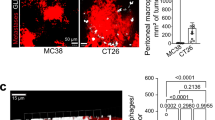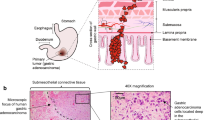Abstract
Peritoneal dissemination is the most common mode of metastasis in gastric cancer. We previously reported the importance of milky spots (MS), peritoneal lymphoid tissues, as selective sites of cancer implantation in peritoneal dissemination. In the present study, we first demonstrated that intraperitoneal injection of adenovirus vector encoding the GFP gene into tumor-free nude mice resulted in GFP expression at omental and mesenteric MS; MS macrophages were target cells for adenovirus infection. We confirmed that intraperitoneal injection of adenovirus vector encoding the NK4 gene (AdNK4) resulted in NK4 production localized to the peritoneal cavity, especially the omentum. Adenovirus vector-mediated MS-selective transgene expression was markedly impaired in tumor-bearing mice whose MS had already been replaced by infiltrating cancer cells. However, prior injection of AdNK4 successfully inhibited MS-selective cancer cell implantation, resulting in suppression of peritoneal dissemination and prolongation of survival. Adenovirus vector-mediated MS-selective delivery of a therapeutic gene may prevent peritoneal dissemination of gastric cancer.
This is a preview of subscription content, access via your institution
Access options
Subscribe to this journal
Receive 12 print issues and online access
$259.00 per year
only $21.58 per issue
Buy this article
- Purchase on Springer Link
- Instant access to full article PDF
Prices may be subject to local taxes which are calculated during checkout






Similar content being viewed by others
References
Averbach AM, Jacquet P . Strategies to decrease the incidence of intra-abdominal recurrence in resectable gastric cancer. Br J Surg. 1996;83:726–733.
Moriguchi S, Maehara Y, Korenaga D, et al. Risk factors which predict pattern of recurrence after curative surgery for patients with advanced gastric cancer. Surg Oncol. 1992;1:341–346.
Boku T, Nakane Y, Minoura T, et al. Prognostic significance of serosal invasion and free intraperitoneal cancer cells in gastric cancer. Br J Surg. 1990;77:436–439.
Sautner T, Hofbauer F, Depisch D, et al. Adjuvant intraperitoneal cisplatin chemotherapy does not improve long-term survival after surgery for advanced gastric cancer. J Clin Oncol. 1994;12:970–974.
Shimotsuma M, Shields JW, Simpson-Morgan MW, et al. Morpho-physiological function and role of omental milky spots as omentum-associated lymphoid tissue (OALT) in the peritoneal cavity. Lymphology. 1993;26:90–101.
Shimotsuma M, Simpson-Morgan MW, Takahashi T, et al. Activation of omental milky spots and milky spot macrophages by intraperitoneal administration of a streptococcal preparation, OK-432. Cancer Res. 1992;52:5400–5402.
Dux K . Role of the greater omentum in the immunological response of mice and rats to the intraperitoneal inoculation of Ehrlich ascites tumor. Arch Immunol Ther Exp. 1969;17:425–432.
Green JA, Williams AE . The relationship between inflammatory responses and WBP1 tumour cell attachment to the rat omentum. Eur J Cancer. 1978;14:1153–1155.
Hagiwara A, Takahashi T, Sawai K, et al. Milky spots as the implantation site for malignant cells in peritoneal dissemination in mice. Cancer Res. 1993;53:687–692.
Tsujimoto H, Takahashi T, Hagiwara A, et al. Site-specific implantation in the milky spots of malignant cells in peritoneal dissemination: immunohistochemical observation in mice inoculated intraperitoneally with bromodeoxyuridine-labelled cells. Br J Cancer. 1995;71:468–472.
Hagiwara A, Takahashi T, Kojima O, et al. Prophylaxis with carbon-adsorbed mitomycin against peritoneal recurrence of gastric cancer. Lancet. 1992;339:629–631.
Rosen HR, Jatzko G, Repse S, et al. Adjuvant intraperitoneal chemotherapy with carbon-adsorbed mitomycin in patients with gastric cancer: results of a randomized multicenter trial of the Austrian Working Group for Surgical Oncology. J Clin Oncol. 1998;16:2733–2738.
Nakamura T, Matsumoto K, Kiritoshi A, et al. Induction of hepatocyte growth factor in fibroblasts by tumor-derived factors affects invasive growth of tumor cells: in vitro analysis of tumor–stromal interactions. Cancer Res. 1997;57:3305–3313.
Seslar SP, Nakamura T, Byers SW . Regulation of fibroblast hepatocyte growth factor/scatter factor expression by human breast carcinoma cell lines and peptide growth factors. Cancer Res. 1993;53:1233–1238.
Kuniyasu H, Yasui W, Kitadai Y, et al. Frequent amplification of the c-Met gene in scirrhous type stomach cancer. Biochem Biophys Res Commun. 1992;189:227–232.
Kaji M, Yonemura Y, Harada S, et al. Participation of c-Met in the progression of human gastric cancers: anti-c-met oligonucleotides inhibit proliferation or invasiveness of gastric cancer cells. Cancer Gene Ther. 1996;3:393–404.
Inoue T, Chung YS, Yashiro M, et al. Transforming growth factor-beta and hepatocyte growth factor produced by gastric fibroblasts stimulate the invasiveness of scirrhous gastric cancer cells. Jpn J Cancer Res. 1997;88:152–159.
Yashiro M, Chung YS, Inoue T, et al. Hepatocyte growth factor (HGF) produced by peritoneal fibroblasts may affect mesothelial cell morphology and promote peritoneal dissemination. Int J Cancer. 1996;67:289–293.
Date K, Matsumoto K, Shimura H, et al. HGF/NK4 is a specific antagonist for pleiotrophic actions of hepatocyte growth factor. FEBS Lett. 1997;420:1–6.
Date K, Matsumoto K, Kuba K, et al. Inhibition of tumor growth and invasion by a four-kringle antagonist (HGF/NK4) for hepatocyte growth factor. Oncogene. 1998;17:3045–3054.
Kuba K, Matsumoto K, Date K, et al. HGF/NK4, a four-kringle antagonist of hepatocyte growth factor, is an angiogenesis inhibitor that suppresses tumor growth and metastasis in mice. Cancer Res. 2000;60:6737–6743.
Tomioka D, Maehara N, Kuba K, et al. Inhibition of growth, invasion, and metastasis of human pancreatic carcinoma cells by NK4 in an orthotopic mouse model. Cancer Res. 2001;61:7518–7524.
Saimura M, Nagai E, Mizumoto K, et al. Tumor suppression through angiogenesis inhibition by SUIT-2 pancreatic cancer cells genetically engineered to secrete NK4. Clin Cancer Res. 2002;8:3243–3249.
Saimura M, Nagai E, Mizumoto K, et al. Intraperitoneal injection of adenovirus-mediated NK4 gene suppresses peritoneal dissemination of pancreatic cancer cell line AsPC-1 in nude mice. Cancer Gene Ther. 2002;9:799–806.
Maehara N, Nagai E, Mizumoto K, et al. Gene transduction of NK4, HGF antagonist, inhibits in vitro invasion and in vivo growth of human pancreatic cancer. Clin Exp Metastasis. 2002;19:417–426.
Saga Y, Mizukami H, Suzuki M, et al. Expression of HGF/NK4 in ovarian cancer cells suppresses intraperitoneal dissemination and extends host survival. Gene Therapy. 2001;8:1450–1455.
Maemondo M, Narumi K, Saijo Y, et al. Targeting angiogenesis and HGF function using an adenoviral vector expressing the HGF antagonist NK4 for cancer therapy. Mol Ther. 2002;5:177–185.
Hirao S, Yamada Y, Koyama F, et al. Tumor suppression effect using NK4, a molecule acting as an antagonist of HGF, on human gastric carcinomas. Cancer Gene Ther. 2002;9:700–707.
Heideman DA, van Beusechem VW, Bloemena E, et al. Suppression of tumor growth, invasion and angiogenesis of human gastric cancer by adenovirus-mediated expression of NK4. J Gene Med. 2004;6:317–327.
Kozarsky KF, Wilson JM . Gene therapy: adenovirus vectors. Curr Opin Genet Dev. 1993;3:499–503.
Hampl M, Tanaka T, Albert PS, et al. Therapeutic effects of viral vector-mediated antiangiogenic gene transfer in malignant ascites. Hum Gene Ther. 2001;12:1713–1729.
Herz J, Gerard RD . Adenovirus-mediated transfer of low-density lipoprotein receptor gene acutely accelerates cholesterol clearance in normal mice. Proc Natl Acad Sci USA. 1993;90:2812–2816.
Morsy MA, Alford EL, Bett A, et al. Efficient adenoviral-mediated ornithine transcarbamylase expression in deficient mouse and human hepatocytes. J Clin Invest. 1993;92:1580–1586.
Jaffe HA, Danel C, Longenecker G, et al. Adenovirus-mediated in vivo gene transfer and expression in normal rat liver. Nat Genet. 1992;1:372–378.
Smith TA, Mehaffey MG, Kayda DB, et al. Adenovirus mediated expression of therapeutic plasma levels of human factor IX in mice. Nat Genet. 1993;5:397–402.
Tao N, Gao GP, Parr M, et al. Sequestration of adenoviral vector by Kupffer cells leads to a nonlinear dose response of transduction in liver. Mol Ther. 2001;3:28–35.
Wolff G, Worgall S, van Rooijen N, et al. Enhancement of in vivo adenovirus-mediated gene transfer and expression by prior depletion of tissue macrophages in the target organ. J Virol. 1997;71:624–629.
Cristiano RJ, Roth JA . Epidermal growth factor mediated DNA delivery into lung cancer cells via the epidermal growth factor receptor. Cancer Gene Ther. 1996;3:4–10.
Wheeler MD, Yamashina S, Froh M, et al. Adenoviral gene delivery can inactivate Kupffer cells: role of oxidants in NF-kappaB activation and cytokine production. J Leukoc Biol. 2001;69:622–630.
Wheeler MD, Kono H, Yin M, et al. Delivery of the Cu/Zn-superoxide dismutase gene with adenovirus reduces early alcohol-induced liver injury in rats. Gastroenterology. 2001;120:1241–1250.
Kanerva A, Wang M, Bauerschmitz GJ, et al. Gene transfer to ovarian cancer versus normal tissues with fiber-modified adenoviruses. Mol Ther. 2002;5:695–704.
Heel KA, Hall JC . Peritoneal defenses and peritoneum-associated lymphoid tissue. Br J Surg. 1996;83:1031–1036.
Folkman J . Angiogenesis in cancer, vascular, rheumatoid and other diseases. Nat Med. 1995;1:27–31.
Liotta LA, Steeg PS, Stetler-Stevenson WG . Cancer metastasis and angiogenesis: an imbalance of positive and negative regulation. Cell. 1991;64:327–336.
Krist LF, Kerremans M, Koenen H, et al. Novel isolation and purification method permitting functional cytotoxicity studies of macrophages from milky spots in the greater omentum. J Immunol Methods. 1995;184:253–261.
Acknowledgements
This study was supported by a Grant-in-Aid for Young Scientists and a Grant-in-Aid for Scientific Research from the Ministry of Education, Culture, Sports, Science and Technology of Japan.
Author information
Authors and Affiliations
Corresponding author
Rights and permissions
About this article
Cite this article
Fujiwara, H., Kubota, T., Amaike, H. et al. Suppression of peritoneal implantation of gastric cancer cells by adenovirus vector-mediated NK4 expression. Cancer Gene Ther 12, 206–216 (2005). https://doi.org/10.1038/sj.cgt.7700782
Received:
Published:
Issue Date:
DOI: https://doi.org/10.1038/sj.cgt.7700782
Keywords
This article is cited by
-
NK4, an HGF antagonist, prevents hematogenous pulmonary metastasis by inhibiting adhesion of CT26 cells to endothelial cells
Clinical & Experimental Metastasis (2009)
-
Suppression of growth of Hela, EJ, SK-OV-3 and MDA-MB-231 cells by recombinant human NK4
Chinese Journal of Cancer Research (2009)
-
Inhibition of angiogenesis and HGF-cMET-elicited malignant processes in human hepatocellular carcinoma cells using adenoviral vector-mediated NK4 gene therapy
Cancer Gene Therapy (2005)



